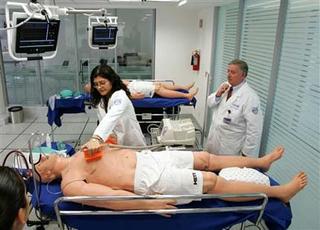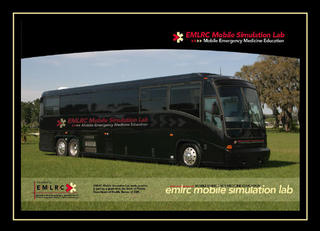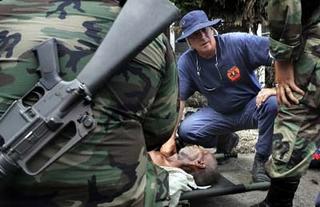A longer post, but an extraordinary story featuring one of the most widely respected physicians in trauma care:
"Unruly crowds disrupt, prevent hospital evacuations"
(AP) -- Doctors at two desperately crippled hospitals in New Orleans called The Associated Press Thursday morning pleading for rescue, saying they were nearly out of food and power and had been forced to move patients to higher floors to escape looters.
"We have been trying to call the mayor's office, we have been trying to call the governor's office ... we have tried to use any inside pressure we can. We are turning to you. Please help us," said Dr. Norman McSwain, chief of trauma surgery at Charity Hospital, the largest of two public hospitals.
Charity is across the street from Tulane University Medical Center, a private facility that has almost completed evacuating more than 1,000 patients and family members, he said.
No such public resources are available for Charity, which has about 250 patients, or University Hospital several blocks away, which has about 110 patients.
"We need coordinated help from the government," McSwain said.
He described horrific conditions. (Watch a report on the scenes of death and despair on the streets of New Orleans -- 4:36)
"There is no food in Charity Hospital. They're eating fruit bowl punch and that's all they've got to eat. There's minimal water," McSwain said.
"Most of their power is out. Much of the hospital is dark. The ICU (intensive care unit) is on the 12th floor, so the physicians and nurses are having to walk up floors to see the patients."
Dr. Lee Hamm, chairman of medicine at Tulane University, said he took a canoe from there to the two public hospitals, where he also works, to check conditions.
"The physicians and nurses are doing an incredible job, but there are patients laying on stretchers on the floor, the halls were dark, the stairwells are dark. Of course, there's no elevators. There's no communication with the outside world," he said.
"We're afraid that somehow these two hospitals have been left off ... that somehow somebody has either forgotten it or ignored it or something, because there is no evidence anything is being done."
Hamm said there was relief Wednesday as word traveled throughout University Hospital that the National Guard was coming to evacuate them, but the rescue never materialized.
"You can imagine how demoralizing that was," he said.
Throughout the entire city, the death, destruction and depravity deepened even as the hurricane waters leveled off.
"Hospitals are trying to evacuate," said Coast Guard Lt. Cmdr. Cheri Ben-Iesan, spokesman at the city emergency operations center. "At every one of them, there are reports that as the helicopters come in people are shooting at them. There are people just taking pot shots at police and at helicopters, telling them, 'You better come get my family."'
Richard Zuschlag, president of Acadian Ambulance Service Inc., described the chaos at a suburban hospital.
"We tried to airlift supplies into Kenner Memorial Hospital late last evening and were confronted by an unruly crowd with guns, and the pilots refused to land," he said.
"My medics were crying, screaming for help. When we tried to land at Kenner, my pilots got scared because 100 people were on the helipad and some of them had guns. He was frightened and would not land."
Zuschlag said 65 patients brought to the roof of another city hospital, Touro Infirmary, for evacuation Wednesday night spent the night there. The hospital's generator and backup generator had failed, and doctors decided it was safer to keep everyone on the roof than carry fragile patients back downstairs.
"The hospital was so hot that with no rain or anything, they were better off in the fresh air on the roof," he said.
When patients have been evacuated, where to take them becomes the next big decision.
"They're having to make strategic decisions about where to send people literally in midair," said John Matessino, president of the Louisiana Hospital Association. "It's a very difficult thing to prioritize when they're all a priority."
Knox Andress, an emergency nurse who is regional coordinator for a federal emergency preparedness grant covering the state, said it's impossible to underestimate the critical role hospitals are playing for anyone left in the city.
"They're running out of their medications, they're running out of money. They're having social issues and where do they go? They go to the hospital. The hospital is the backbone of the community because the lights are always on," he said.
When hospitals can't take care of people and the rescuers need rescued, there's no social fabric left, Andress said.
Hospitals weren't the only facilities with troubles.
Louisiana Lt. Gov. Mitch Landrieu, who has been working with search and rescue, confirmed that 30 people died at a nursing home in St. Bernard Parish and 30 others were being evacuated. He did not give any further details.
Copyright 2005 The Associated Press. All rights reserved.This material may not be published, broadcast, rewritten, or redistributed.







